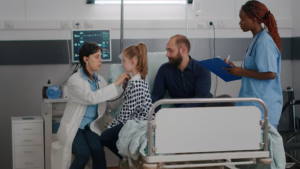The Future of Sonography in Allied Health: Challenges & Opportunities
In a quiet corner of a busy hospital, a sonographer moves a transducer over a patient’s abdomen, displaying on screen a tiny, flickering heartbeat. Sonography has been the hero of diagnostic medicine for decades —noninvasive, radiation-free, able to capture some of life’s most intimate moments.
However, with new technologies continuing to evolve and the demand for healthcare steadily increasing, sonography is finding its place in a new technologically innovative world.
Through Artificial Intelligence (AI) and portable devices, innovations are reshaping the allied health landscape and are poised to foster better patient care while making it more accessible and providing a new vision of the role of the sonographers.
The Evolution of Sonography: From Black-and-White to Cutting-Edge
Since its inception in the 1950s, sonography, commonly referred to as ultrasound, has made tremendous strides. The earliest machines spit out pixelated, flat images that demanded expert interpretation.
Today, high-resolution 3D and 4D scans enable clinicians to visualize organs, blood flow, and even fetal movements with astonishing clarity. However, the next wave of innovation is upon us.
The practice of modern sonography is not restricted to obstetrics. It’s now one of the most important tools in cardiology, emergency medicine, musculoskeletal evaluations, and even cancer detection.
As an example, contrast-enhanced ultrasound (CEUS) shows great potential as a safe, low-cost alternative to CT scans for liver lesion characterization.
Meanwhile, handheld ultrasound devices — small enough to fit in one hand and no larger than a smartphone — are enabling paramedics, rural clinicians, and even astronauts on the International Space Station to perform life-saving diagnostics on the fly.
AI and Automation: Partners, Not Replacements
One of the most exciting — and debated — changes in sonography is the incorporation of AI. The prospect of machines doing jobs once performed by human beings worries critics, but the reality is much more collaborative. AI Algorithms Are Trained to Read Ultrasound Exam Images (for Conditions Such as Blood Clots).
For example, AI can immediately assess cardiac ejection fractions or identify subtle signs of breast cancer that may elude the human eye.
A study published in Nature Medicine discovered that AI-assisted ultrasound analysis increased accuracy by 22 percent in identifying cases of pediatric appendicitis, allowing for a reduction in unnecessary surgeries.
But AI is not here to replace you. Rather, it’s liberating sonographers from repetitive tasks so they can attend to more complicated cases and chat with patients.
Portable Ultrasound: Democratizing Diagnostics
Imagine a physician in a waveswept Kenyan village detecting a cardiac defect by using pocket-sized ultrasound wired to a tablet—merely theoretically. And this is no longer strict science fiction.
Portable ultrasound machines are revolutionizing medicine by putting diagnostic technology in the hands of people in places with little or no access to healthcare, in disaster zones, and even in patients’ homes across the globe.
Companies like Butterfly Network have led the charge to develop handheld ultrasound probes that plug into smartphones and whose image quality is comparable to traditional machines but cost a fraction of the price.
These devices are particularly revolutionary in emergency settings, where swift scourings are needed to assess trauma patients, and a split-second choice can mean life or death.
Point-of-care testing and integration with telemedicine, according to an analysis, peg the global market for portable ultrasound devices at about $5.7 billion by 2030.
For sonographers, this mobility means practicing in a foreign space and interacting with non-specialist care providers. There is now a training program to teach “ultrasound literacy” to nurses, midwives, and primary care providers so the technology is used appropriately outside of imaging departments.
Education and Training: Preparing for a Tech-Driven Future
Sonography technologies emerge, yet education must evolve. Old-school programming also taught anatomy, patient care, and machine operation.
However, robotics, telehealth protocols, and AI literacy are among the curricula of today. Virtual reality (VR) simulations, for example, let students “practice” scanning virtual patients, honing their skills without danger.
The reality is that the future generation of sonographers is going to have to be tech-savvy and adaptable. They’ll work alongside AI, they’ll interpret data that comes from wearable ultrasound monitors, and they’ll potentially pilot drones that carry ultrasound to the scene of the emergency.
Disciplinary cross-cuts are also on the move. Sonographers work more and more in collaborative teams of professionals that include radiologists, surgeons, and data scientists.
This is not only good for patients but frees up sonographers to specialize in vascular sonography or pediatric echocardiography.
Ethical Considerations and Challenges Ahead
The future is bright, but there will be challenges. The rapid deployment of artificial intelligence creates its own questions about liability: Who is to blame if an algorithm fails to deliver a critical diagnosis? There are also privacy concerns, as ultrasound data is sent across cloud platforms and telemedicine networks.
In addition, sonography’s emotional labor is underappreciated. Sonographers routinely deliver life-altering news — an incurable illness, a miscarriage — while grappling with their own stress.
A survey found that 38% of sonographers are suffering moderate to severe burnout as a result of excessive workloads and emotional exhaustion, and burnout rates in the profession are on the rise.
We will need systemic change for these challenges to be met: increased access to mental health support, defined governance for AI, and advocacy for sonographers to have a place in the policy landscape.
The Human Touch in a High-Tech World
Although there is lots of buzz around gadgets and algorithms, the core of sonography is very, very human. Let’s say there’s a 28-year-old sonographer named Sarah who works in a prenatal clinic.
She recalls scanning a high-risk pregnancy in which an AI system flagged a potential heart defect. After a tense consult with a fetal cardiologist, the family ascertained that their baby would need surgery after birth. “Closer to the end, the AI helped us act faster,” Sarah says, “but holding that mother’s hand and explaining each step on the way — that’s something no machine can replace.”
Balancing this high-tech/low-touch care will define the future of the field of sonography.” As machines handle the tedious particulars, sonographers will have the time to educate patients, advocate for preventive care, and model the empathy that no algorithm can imitate.
Sonography In Allied Health: A New Era of Possibilities
Sonography’s future is one of an interweaving of all three.” From AI-boosted diagnostics to palm-sized devices saving lives on battlefields, the field is smashing barriers that once looked as if they would never budge.
But, at the essence of sonography will always be a successful blend of technical ability and humanity, brought to life by people. For those seeking a dream career as a sonographer, this changing landscape is full of amazing opportunities—pioneering new techniques, bridging gaps in the healthcare system, and cradling some of the most miraculous moments in medicine.
For patients, it offers quicker, safer, and more readily available care. As technology continues to grow and adapt, one fact will always remain: The heart of sonography will forever be human.
Ready to explore exciting career opportunities in sonography and allied health? Visit StaffDNA today and take the next step toward your dream job!
Check out these other great Staffdna articles

Hospitalist Jobs vs. General Physician Assistant Jobs: What’s the Difference?
When medical professionals are considering their career options, the first things that come to mind are either hospitalists or general physician assistants.

Busting Myths About PRN Nursing Jobs: Pros, Cons & How to Find the Best Shifts
PRN nursing jobs have become a favorite among medical professionals looking for flexibility and higher pay. Yet, many misconceptions exist about PRN positions that scare some nurses away from considering it as a career choice.

How to Handle the Pressure of PACU Nursing Jobs Without Burning Out
Nursing is a demanding field, which becomes even more challenging when it comes to PACU nursing jobs.

How to Transition from Staff Nurse to A Travel Nurse
If you are a Registered Nurse with a strong desire to travel to different locations and save lives, you can be a travel nurse.

Travel Nursing: How to Choose the Best Career Assignments
Travel nursing is one way for nurses to work through new locations while also building their skill sets.

Understanding the PICU: A Guide for PICU Nurses
The pediatric intensive care unit (PICU) is a specialized department in hospitals and medical facilities. It is made to provide intensive care to infants, children, and adolescents with severe medical conditions.
